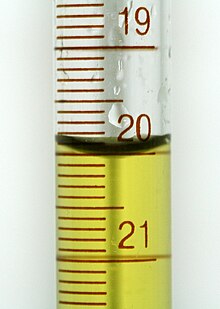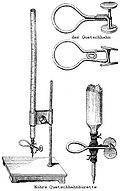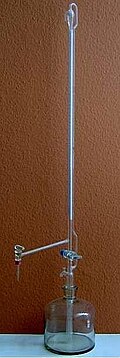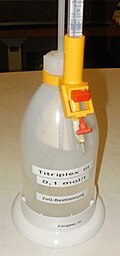burette


A burette (French: burette jug; outdated: discharge rosette) is a calibrated, vertical glass tube with a scale and a tap at the bottom. It is used in the chemical laboratory to measure small volumes of liquid in titration ( dimensional analysis ).
description
On the front there is a graduation (in milliliters , ml) printed on the glass tube (previously etched), on the back of the tube there is often a white stripe with a blue line (the so-called Schellbach stripe ), which when looking through the Burette at the lowest point of the meniscus forms a pointer, which increases the reading accuracy. This avoids a parallax error when reading with the eye . All burettes are adjusted to the outlet ("to 'Ex'"), which means that the difference in the scale reading shows the volume of liquid that has leaked out and does not record the volume of liquid still adhering to the glass wall. Burettes are available in clear glass, clear glass with Schellbach stripes or amber glass. The drain cock can be attached directly under the glass tube or on the side and is a cock with a ground glass or Teflon plug, a pinch cock or a valve cock .
In the case of simple models, the custom-made solution must be poured in at the top. Burettes (pellet titration apparatus) with or without an intermediate stopcock with normal ground joint NS 29/32, which are placed directly on a storage bottle (usually 2000 ml, clear glass or amber glass) with volumetric solution, are more convenient. With these inlet burettes, the standard solution is pumped from the storage bottle upwards through a glass tube on the side and into the burette by creating an overpressure in the storage bottle with a rubber blower with a valve and connection hose for titration apparatus. They have an automatic zero point adjustment, i. H. the excess liquid flows back into the storage bottle through the inlet pipe, which is adjusted to the zero mark. With the titration apparatus according to Dr. Schilling, a storage bottle made of polyethylene (PE) is used for quick filling (narrow-necked bottle with hose feed-through). It is compressed, whereby the standard solution is pressed up through a PVC filling hose into the glass burette. This burette also has an automatic zero point adjustment.
Class A burettes have the highest accuracy. An accuracy of 1/500 to 1/1000 can be achieved with a calibrated 50 mL burette.
- Important accessories / spare parts for burettes / titration apparatus
- Burette tube
- Burette stopcock
- Burette cap PP
- Burette clamp
- Buret tip for PTFE stopcock
- Burette stand
- Rubber blower with or without a net
- Joint grease , silicone-free for oiling Bürettenhähnen
- chick
- Storage bottle made of clear glass or amber glass, 2000 ml
- for titration apparatus according to Dr. Shilling
- Fitting (micro screw for fine trituration and push button including retaining clip)
- Spare burette 10, 15, 25, 50 ml, 25 + 50 ml amber glass
- PVC filling hose, transparent
- Glass spout tip with silicone tube
- Stand PE for bottle 500 ml or 1000 ml
- Storage bottle, narrow neck, made of PE with hose feed-through, 500 ml, 1000 ml, 1000 ml brown
Digital burettes
Digital burettes are usually available in sizes between 10 ml and 50 ml and are screwed directly onto the storage bottle. They have a cylinder with a piston that is mechanically filled with the standard solution , a valve that prevents the standard solution from being pushed back into the storage bottle, and an outlet capillary. The titration is carried out by the automatically controlled advance of the piston (piston burette ). The titrated volume is shown on a digital display with an accuracy of up to 0.01 ml.
Electronic burettes
There are electronic burettes with a resolution of up to 0.001 ml, which enable dosing with the highest precision and a precisely controllable titration process. Together with a glass electrode for pH detection and a control and evaluation device, these form an automatic titration system. These burettes mostly consist of a basic device with an electronically controlled stepper motor and a trigger. Piston burettes of various sizes are connected to the basic device and are automatically filled from a storage bottle with the aid of the stepper motor. By pressing the trigger, the liquid in the piston burette is ejected through a hose at a predefined speed and the volume is displayed on the basic device.
history
The first burette was developed in 1791 by the French pharmacist and chemist François Antoine Henri Descroizilles . Joseph Louis Gay-Lussac developed an improved version of a burette with a side arm and in 1824 he coined the terms "pipette" and "burette" in a work on the standardization of indigo solutions. A breakthrough in the methodology and popularization of volumetric analysis came from Karl Friedrich Mohr , who redesigned the burette by attaching a clip and a point to the lower end.
See also
Web links
Individual evidence
- ^ Walter Wittenberger: Chemische Laboratoriumstechnik , Springer-Verlag, Vienna, New York, 7th edition, 1973, p. 90, ISBN 3-211-81116-8 . ( limited preview in Google Book search).




